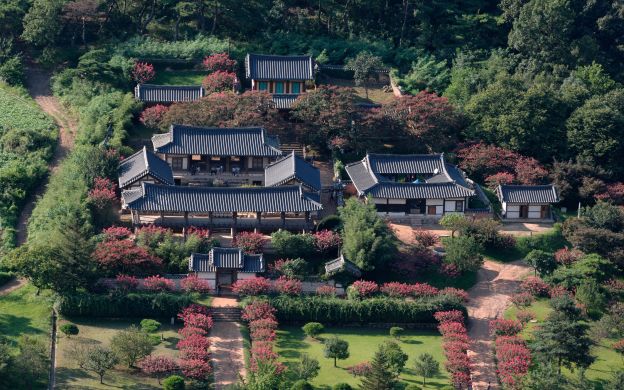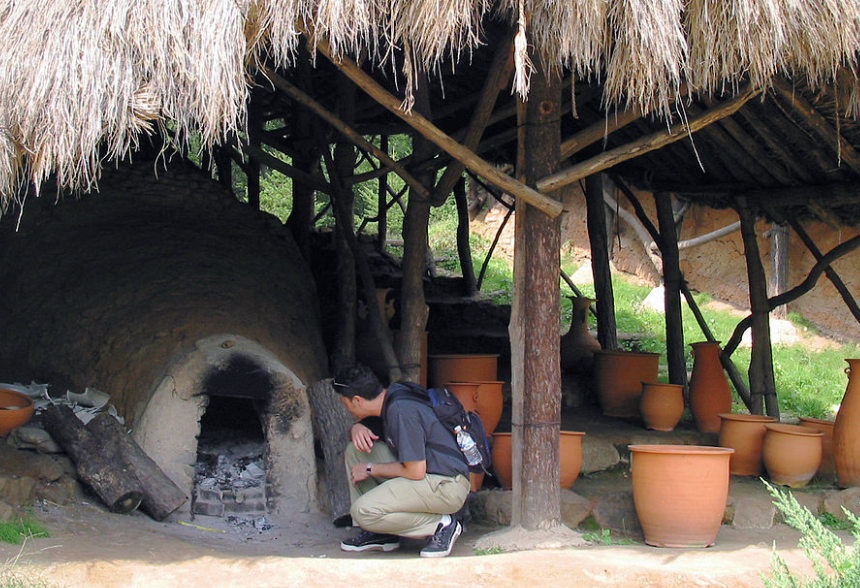Today, we will visit two traditional villages in South Korea: Hahoe and Yangdong, both inscribed on the World Heritage List since 2010. The promise of a genuine return to the past awaits, where we can finally immerse ourselves in the “real Korean culture,” perhaps to better embrace it.
1- The traditional Hahoe village in Andong

Hahoe Folk Village in Andong, South Korea, is a traditional village that has preserved Joseon architecture, traditions, ancient books, and Hahoetal masks. This village is located on the Hwachon, a tributary of the Nakdong. To the north lies the Buyongdae cliff, and to the south is Mount Namsan. The village is organized according to the geomantic principles of pungsu, resembling the shape of a lotus flower.
This village is a valuable part of Korean culture, preserving Joseon period-style architecture, folk traditions, valuable books, and the old tradition of clan-based villages. It was listed by the South Korean government with UNESCO as a World Heritage Site along with Yangdong Folk Village in 2010, attracting around 1 million visitors every year.

This UNESCO World Heritage Site was visited by Queen Elizabeth II in 1999 and is best known for its traditional houses with tiled or thatched roofs. The village offers an impressive landscape surrounded by the Nakdong River, the magnificent Buyongdae Cliff, and fine sandy beaches. Visitors can take a boat to the cliff to enjoy a panoramic view of the village.
Founded in the 14th-15th century, Hahoe is one of the most representative historic clan villages in South Korea, along with Yangdong. The settlement includes residences of head families and clan members, pavilions, Confucian academies, and study pavilions that reflect the aristocratic Confucian culture of the early Joseon. Within the village, six houses out of 124 have been designated as National Treasures.
To the north of the village is the Buyongdae Cliff, while Mt. Namsan lies to the south. The village is organized around the geomantic guidelines of pungsu (Korean feng shui), giving it the shape of a lotus flower or two interlocking comma shapes.

History
The Ryu (or Yu in some transcriptions) clan of Pungsan established Hahoe Folk Village in the 15th century during the Joseon Dynasty and has been a one-clan community since then. The village is notable for preserving many of its original structures, such as the village Confucian school and other buildings, and for maintaining folk arts such as the Hahoe Mask Dance Drama (‘Byeonlsin-gut’), which is a shamanist rite honoring the communal spirits of the village.
The village today is divided into Namchon (South Village) and Pukchon (North Village), with the main branch of the Pungsan Ryu clan, the Gyeomampa, in the Namchon side and the secondary branch, the Seoaepa, descended from Ryu Seong-ryong, a noted prime minister during the reign of King Seonjo of Joseon, in the Bukchon side. The north village contains Yangjindang Manor, designated as Treasure No. 306, and Pikchondaek House, designated Important Folklore Material No. 84. The south village contains Chunghyodang Manor, designated as Treasure No. 414, and Namchondaek House, an Important Folklore Material No. 90. While each branch of the Pungsan Ryu clan used to live in their respective manor homes and sides, today both branches live throughout the village.

The village maintains old architectural styles that have been lost due to rapid modernization and development in South Korea. Aristocratic tile-roofed residences and thatched-roof servants’ homes preserve the architectural styles of the Joseon Dynasty. Notable structures in the village include Wonjijeongsa Pavilion and Byeongsan Confucian School.
The village has preserved the shamanist rite of Byeolsin-gut and Hahoe masks used in the Hahoe Mask Dance. Another practiced rite is the Jeulbul Nori, which involves strings of fireworks fired at the base of the Buyongdae Cliff. Yongmogak Shrine houses Ryu Seong-ryong’s collection of books, including South Korean National Treasure No. 132, the Jingbirok, a book recording the Imjin War of Korea in 1592. Treasure No. 160, Kunmundungok, is a record of military encampments. Chunghyodang also holds 231 royal writs of appointment.
Inside the village, there is a 650-year-old zelkova tree called Samsindan, said to be home to the goddess Samsin in Korean Shamanism. Visitors write their wishes on pieces of paper and hang them next to the tree.
Queen Elizabeth II visited Hahoe Village in 1999, and during her visit, locals in the village prepared a party to celebrate her 73rd birthday.
Intangible Cultural Asset
Hahoe Byeolsingut Mask Play The mask play, played in Hahoe-ri, Pungcheon-myeon, Andong City, North Gyeongsang Province, is National Intangible Cultural Festival No. 69. The origin of this mask play is Seonangje’s mask dance, an involuntary dramatic victory observed in Dongje, unlike Sandae Myeonghwajeon, a Korean traditional mask play. Byeolsingut Tal Nori is a mask play included in the overall village rite, and it is a mixture of ritual, folk opera, and pantomime.
Sunyu Line Fire ‘Sunyu Line Fire’ is a folk game in which people hang a bag filled with charcoal powder on a long string hanging in the air and enjoy a spectacular event in which flames come on fire. In Andong’s Hahoe Village, aristocrats went boating together with a poem and a song under the full moon in July. At this time, they enjoyed pouring oil on eggshells or buppy pieces and flying them with a wick, or dropping pine tree stems that had been lit on Buyongdae.
Tourism
Yangdong Folk Village, designated as a World Heritage site since 2010, offers a unique experience for visitors. The village’s historical significance, traditional architecture, and cultural assets contribute to its popularity.
The village attracts tourists with its well-preserved traditional yangban lifestyle and Neo-Confucian traditions. The picturesque setting along the Hyeongsan River and the presence of Mt. Seolchang add to the village’s allure. Mucheomdang, the primary house of the Yeogang Yi family, and Seobaekodang, the primary home of the Wolseong Son Family, are prominent attractions.
Over 160 homes, a mix of tile-roofed and thatched-roof houses, are scattered throughout the dense forest, creating a captivating historical ambiance. Fifty-four historic homes over 200 years old stand as testaments to the village’s rich heritage.
Yangdong Village is not only a cultural treasure but also an immersive experience for visitors seeking to understand Korea’s aristocratic past. Its inclusion as a World Heritage site, alongside Hahoe Folk Village, reinforces its significance on the global stage.
As of 2021, measures have been implemented to preserve the village, including restricting tour carts from entering the site. This conservation effort aims to protect the village’s authenticity and maintain its historical integrity for future generations.
In summary, Yangdong Folk Village stands as a living testament to Korea’s aristocratic history, offering visitors a glimpse into the past through its well-preserved architecture, cultural artifacts, and traditional customs.
2- Discover Yangdong Folk Village: a traditional yangban

Yangdong Folk Village (Yangdong Village of Gyeongju) is a traditional yangban (Korean Aristocracy) village from the Joseon dynasty. The village is located in Gangdong-myeon, sixteen kilometers northeast of Gyeongju, Gyeongsangbuk-do, South Korea, along the Hyeongsan River. Mt. Seolchang stands to the north of the village. The village is designated as Important Folklore Materials No. 189 by the South Korean government.

The size, degree of preservation, numerous cultural assets, traditionalism, and beautiful natural setting all contribute to the importance of Yangdong Village. It is also a fine example of the yangban (Korean aristocracy) lifestyle and Neo-Confucian traditions.
The village is listed by the South Korean government with UNESCO as a World Heritage site, along with Hahoe Folk Village in 2010.

The village was founded by Son So (孫昭 1433-1484). The household of the Wolseong Son clan was placed on an auspicious site according to Korean theories of pungsu (geomancy). Son So and his wife, the daughter of Yu Bok Ha, had a daughter who married Yi Beon of the Yeogang Yi family. The marriage produced one of the eighteen sages of Korea, Yi Unjeok. The village of Yangdong has continued since its auspicious beginning in the 15th century.
Although some parts of the village are unoccupied today, it boasts over 160 tile-roofed and thatched-roof homes built throughout the dense forest. Fifty-four historic homes over 200 years old have also been preserved. The village conserves folk customs as well as traditional buildings of traditional Joseon dynasty architecture. Seobaekodang is the primary home of the Wolseong Son Family.

Mucheomdang is the primary house of the Yeogang Yi family. Hyangdan is National Treasure No. 412. Ihayangjeon and Simsujeong pavilions, and the Ganghakdang village school are also notable structures in the village, as well as Gwangajeong and Sonsoyeongjeong. Tonggamsokpyeon, a book printed on movable metal type and National Treasure No. 283, is also located in the village. A picture of the village greets visitors as they enter.
Important folk materials at the village include:

- Seobaekdang
- Nakseondang
- Sahodang
- Sangchunheon
- Geunam Manor
- Dugok Manor
- Sujoldang
- Ihyangjeong
- Suunjeong
- Simsujeong
- Allakjeong
- Ganghakdang
Other cultural properties include:

- Jeokgae Gongsin Nonsang Rokgwan (Tangible Cultural Property )
- Sonso’s Will (Tangible Cultural Property )
- Pine Tree in Yangdong
- Daeseongheon
- Son Jong-ro Jeongchungbigak (Cultural Asset Material No. 261)
- Gyeongsan Seodang (Folk Cultural Asset Material)
- Dugok Yeongdang (Folk Cultural Asset Material).
The village follows the topography of the mountains and valleys and is shaped like an auspicious Hanja character. This arrangement has been carefully preserved. The homes of the Wolseong Son and Yeogang Yi clans, as well as their descendants’ homes, are located on the high ground of the mountains and valleys. The lower-class homes, characterized by their thatched roofs, were built on lower ground. The village’s organization highlights the severe social stratification characteristic of Joseon dynasty society.
Prince Charles visited Yangdong in 1993.
Did you like this article? Do not hesitate to share it on social networks and subscribe to Discover the World on Google News to not miss any articles!